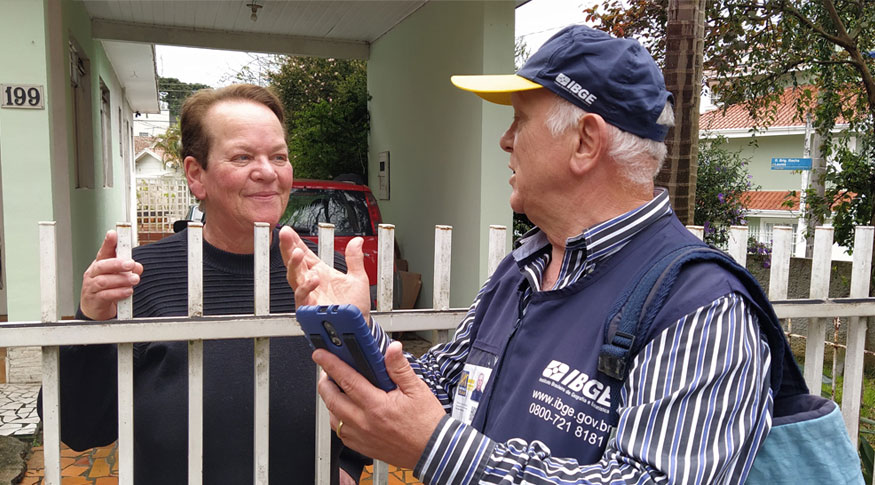2022 Census
IBGE releases coverage analysis of the Post-Enumeration Survey of the 2022 Population Census
August 22, 2024 10h00 AM | Last Updated: August 26, 2024 12h02 PM
Highlights
- In the coverage analysis, the Post-Enumeration Survey of the 2022 Population Census (PPE) maps gaps in the counting of households and/or persons, which can be caused by omission or improper inclusion.
- The net error rate stayed at 8.3% in Brazil.
- The net error rate refers to the total number of persons effectively enumerated in the Census (195,101,203) and not to the final population estimated in the Census (203,080,756).
- The highest omission rates were perceived among children aged between 0 and 4 years and in the young adult population between 20 and 24 years.
- In the regional geography, the Northeast, South and Central-West (except the Federal District) stood below the national average, and the Southeast appears with higher rates, highlighted by Rio de Janeiro, the highest rate among the FUs (15.5%) and São Paulo (10.8%).
- Concerning the size of the muniicpal population, the PPE showed that the larger the municipality, the higher the error rate.
- The PPE is a survey carried out based on a selected sample of enumeration areas, after the data collection of the 2022 Population Census is completed in these areas, aiming at providing resources to assess the coverage and quality of the data collection of the census operation.

The IBGE releases today (22) the analysis of the coverage of the Post-Enumeration Survey (PPE) of the 2022 Population Census. In this work, the IBGE maps gaps in the counting of households and/or persons, which can be caused by omission or improper inclusion. A net error rate of 8.3% was estimated for Brazil, taking into account the population effectively enumerated (195,101,203). The content analysis had already been released in June, with the assessment in the scope of results.
Although it is an independent survey, the PPE is part of the Census project. "Census operations fail in every country. That is why it is important to pinpoint these gaps," explains Juliana Queiroz, the Coordinator of the survey. "The PPE aims at guiding users in the interpretation of the results, serving as input for population estimates and projections, helping to improve future surveys, as well as providing even more data transparency," complements the researcher.
In the coverage analysis, the PPE maps gaps in counting households and/or persons, due to omission or improper inclusion. "For instance: for some reason, an enumerator does not interview a household located in a place with several houses. Another example of omission: a resident not mentioned by the informant, like a young student who spends the week in the university. In the improper inclusion, the reverse happens: a person, who is not a resident, is spending some time in the household, but they are listed as a resident," exemplifies Queiroz.
Coverage Rates of the 2022 Population Census - Brazil
| Net error | Omission | Improper inclusion | Gross error |
|---|---|---|---|
| 8.3% | 12.2% | 3.3% | 14.8% |
The PPE showed that the net error rate stayed at 8.3% in Brazil. However, coverage imprecisions do not happen evenly, varying along characteristics of the population, like sex and age. The highest omission rates were perceived among children aged between 0 and 4 years and in the young adult population between 20 and 24 years, like the example mentioned above by the researcher. "The results observed for the under enumeration of persons by age group match those of the international experiences on this theme. In the case of children, they are usually not listed as residents by many informants," reinforces her.
It should be highlighted that the net error rate refers to the total number of persons effectively enumerated in the Census (195,101,203) and not to the final population estimated in the Census (203,080,756), which considers the population imputed in occupied households without interview in addition to the enumerated population.
In the regional geography and by Federation Unit (FU), the net error rate in the Northeast, South and Central-West (except the Federal District) stood out, standing below the national average. On the other side, the Southeast appears with higher rates, highlighted by Rio de Janeiro (15.5%), the highest one among the FUs and São Paulo (10.8%). "That result involves another geography, which is the error rate by size of the municipal population. "Basically, the larger the population of the municipality, the higher the net error tends to be," states Queiroz, listing the difficulty to cover major urban centers as a challenge for census operations. "Either due to slums and urban communities, or high-middle-class and high-class condominiums or even households with only one resident," complements her. "Recognizing gaps and describing them is one of the needs to carry out assessments like this," completes the researcher.
Survey follows statistical principles and best international practices
A number of countries carry out surveys like the PPE to assess their censuses, like Mexico, United States, United Kingdom, Portugal, Australia, South Africa, China and India, among others. In Brazil, the IBGE goes to the field with studies of this nature since the 1970 Census.
The 2022 PPE was carried out based on a sample of selected enumeration areas after completing the data collection in these areas by the Census. The release of the results follows the statistical principles of responsibility and transparency, as well as it serves as an input to improve future surveys and adjust the Census results, for example, population estimates and projections.
The results are available for Brazil and Federation Units and can be accessed on the IBGE portal.




















